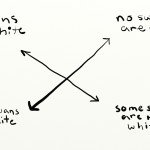No, it’s not a time warp.
Rather, it’s an ancient concept that helps you distinguish between the “almost correct” and “correct” answers.
We can all agree that at a certain level, it’s almost invariably between two correct answers on the GMAT.
This is particularly applicable for the dreaded “inference” questions.
That is, “The passage suggests which of the following…”; “It can be inferred from the passage that…”; “The passage implies that…”, etc.
What distinguishes the correct and the incorrect?
There are a lot of different factors, but a good rule to remember is to go for the more general—the one that allows the most “leeway.”
The most vague, general answer possible.
Think about it like a politician answering a particularly difficult question posed by an interviewer.
It’s not as if the politician is going to get away with NOT answering the question. That would give the interviewer too much ammunition.
No, the politician is going to answer the question and say absolutely nothing.
NOT. A. THING. Except a bunch of hot air, of course. Professional speakers are well versed in how to do this.
That is, they understand how to answer the question in name, but not really say anything.
That is what you can look for in the GMAT Reading Comprehension section.
What answers the question, but is so vague and obvious as to be uninteresting?
Basically, the Reading Comprehension section lays out its answers in two ways:
1) it makes the correct answers less appealing
as we’ve already discussed.
and
2) it makes the incorrect answers more appealing.
How does it make the incorrect answers more appealing?
We are all trained from a young age (or possibly only since university for the Americans—hey, I’m one too!–in the audience) to want to find the answer that “says something.”
The answer seems deep, profound, pointed, or simply interesting.
It makes us sound clever in the eyes of the professor if the idea is nice and pointed, after all.
We all want that pat on the back from the professor, so we try to say something interesting.
However, this will come back to bite us on the GMAT.
How does this work?
Largely, incorrect GMAT answers will misuse quantifiers or verbs (“stop” rather than “reduce,” “abolish” instead of “counteract,” etc.) by making them too extreme.
Quantifiers:
>“all” vs. “many” or “most”
> “every” vs. “most” or “some” and so on…
Verbs:
>“stop” rather than “reduce,”
>“abolish” instead of “counteract,” etc.
Do you see the difference? One is strong and incredibly difficult to support without extreme amounts of evidence.
The other allows for a lot of room for argument. In many cases, it would be HARD TO DISPROVE.
That is why many of the correct answers provoke a “Well, that’s obvious, but it doesn’t say anything” response from the testtaker.
That’s the point!
On to the technique:
In the 3rd century BCE, Aristotle (yes, that one) developed what is known as “The Square of Opposition.”
The Square of Opposition consists of four parts, based on quantifiers:
1) All Swans Are White
2) All Swans Are Not White
3) Some Swans Are White
4) Some Swans Are Not White
It is obvious that 1) and 2) cannot both be true, and are referred to as Oppositions.
The statements 1) and 4) and 2) and 3) are called Contradictories. They cannot both be true.
The relationship between 1) and 3) is the problem. This is the diabolical place where the GMAT catches us out. Now you don’t have to get caught!
Both 1) and 3) can be true, but think about this: if 1) is true, then 3) must be true.
That is, if all swans are white, then some swans, of course, are white.
However, it is possible that 3) is true without 1) being true.
That is, if some swans are white, this does not necessarily mean that all swans are white.
In other words, there could be some white swans and at least one swan of a different color (pink, for example…).
See what a difference quantifiers make?
Additionally, be extra careful of the strength of a verb: “abolish” or “obliterate” signifies a totality, where “reduce” or “hamper” signifies a partiality.
What is the takeaway lesson here?
Look out for your damn quantifiers and verbs!
If you need a swift kick in the quantifier, look no further:
Click HERE to arrange a
FREE PHONE CONSULTATION
p.s. Can you explain to me the difference between Inductive and Deductive reasoning? Which does the GMAT prefer?
p.p.s. Maybe another dead philosopher can help you out. Any suggestions?


